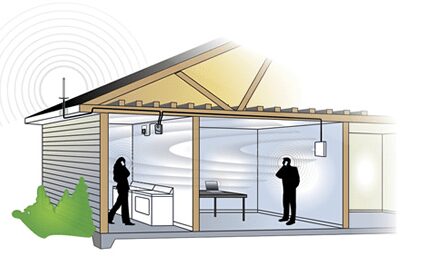California’s Department of Motor Vehicles knew that cellular coverage was inadequate at its Sacramento headquarters. The 500,000-square-foot facility needed to support not only its own workforce but also the hundreds of people who use cellphones while waiting in line each day, many of whom also rely on their mobile devices to present required identification to the state.
With no wireless carrier ready to invest in a distributed antenna system (DAS) for the facility, California turned to cell signal boosters. Cell signal boosters are less powerful than distributed antenna systems, and are also less expensive.
What is a cell signal booster?
Cell signal boosters, also called cellular repeaters, perform three functions. They receive, amplify and then rebroadcast existing cell signals. A cell signal booster will not be a good solution if the signal outside a building is already weak. But if signal deterioration occurs indoors, a cell signal booster can be a very good alternative to a distributed antenna system. They use on-premise power, and the devices are typically small enough for one person to lift and carry easily.
Wilson Electronics and SureCall are two of the leading manufacturers of cell signal boosters. SureCall has a strong presence in the enterprise market, and Wilson has a large share of the residential market. Both manufacturers have solutions that cover the bands of all the leading U.S. wireless carriers, so users can get better connectivity regardless of their carrier. This is not always true with distributed antenna systems, which are usually built to serve one carrier at the outset and accommodate others down the road.
SureCall’s Force 5 cell signal booster covers 80,000 to 100,000 square feet, using 8-10 dome antennas. The company says it was the first manufacturer to cover all five carrier bands in the U.S., and has successfully patented its technology.
Evaluating solutions
Building owners often evaluate connectivity solutions based on the amount they need to spend to cover a certain area. This math can lead many enterprises to cell signal boosters.
“The most expensive installer I know of with our product is under 50 cents a square foot,” said Curt Burkhart, SureCall’s director of sales and marketing. “We see a range on DAS solutions anywhere from $1.50 to $4 per square foot.”
SureCall does not see DAS as the competition; instead the company is finding that as enterprises look into the benefits of a DAS, their investigation often leads to the decision to buy cell signal boosters.
“We really see a lot of our customers come to us after they have explored a DAS solution,” said Burkhart. “Eight out of 10 confirmed eligible buildings that wish for a solution kind of go ‘poof,’ they see the cost and sometimes the time it takes to deploy and they go away. … DAS solution providers are using our system to kind of make those ones that go ‘poof’ turn into a profit center for them.”
Wi-Fi integration looks like the next logical step for manufacturers of cell signal boosters, and Burkhart said that is a likely next step for SureCall.
Follow me on Twitter.
Image source: Wilson Electronics

